Studio Hildebrand
Mag.Art. Christoph Hildebrand
+49 0163 5810594
ch@studio-hildebrand.net




Mag.Art. Christoph Hildebrand
+49 0163 5810594
ch@studio-hildebrand.net




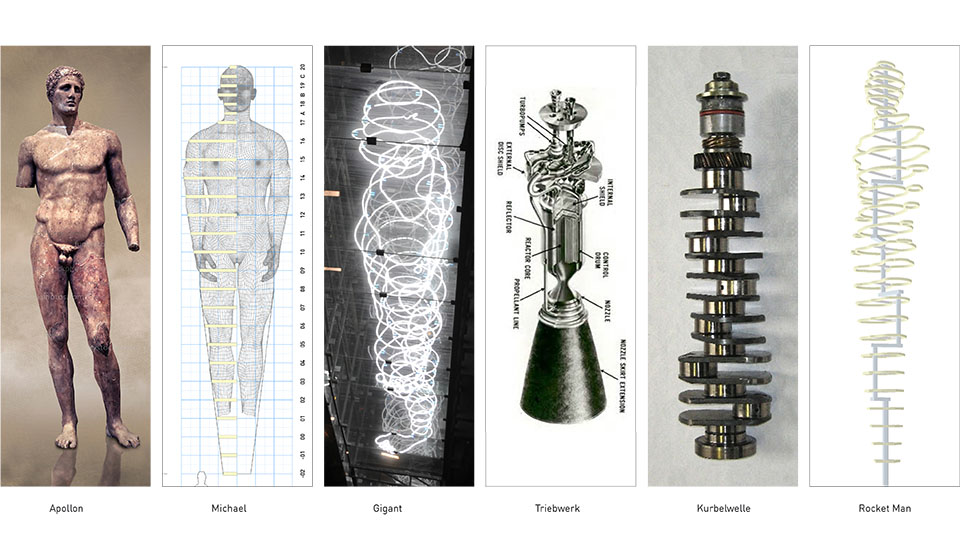
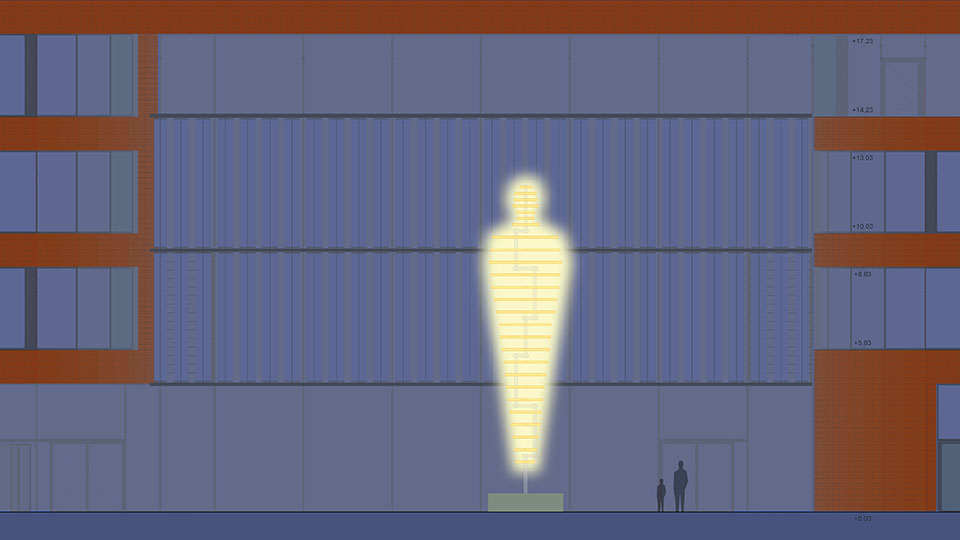
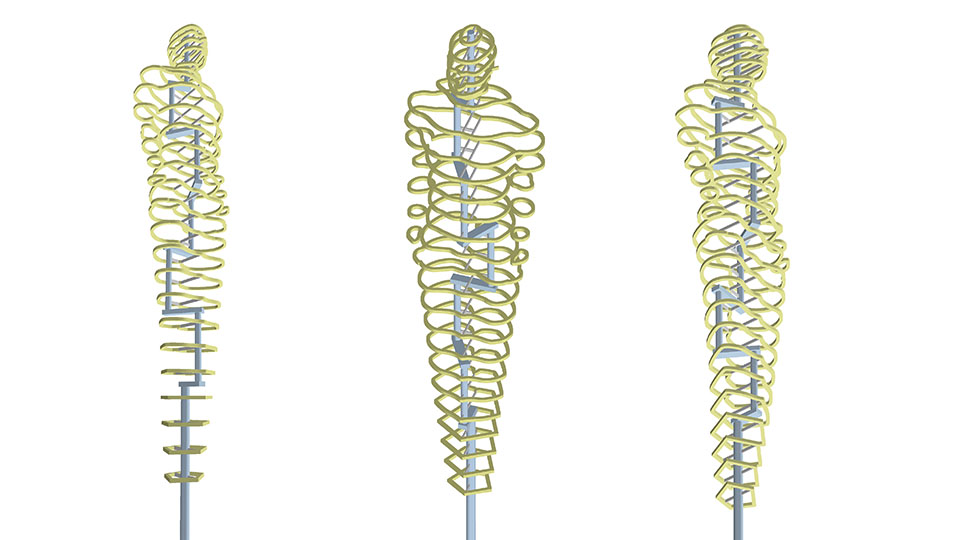
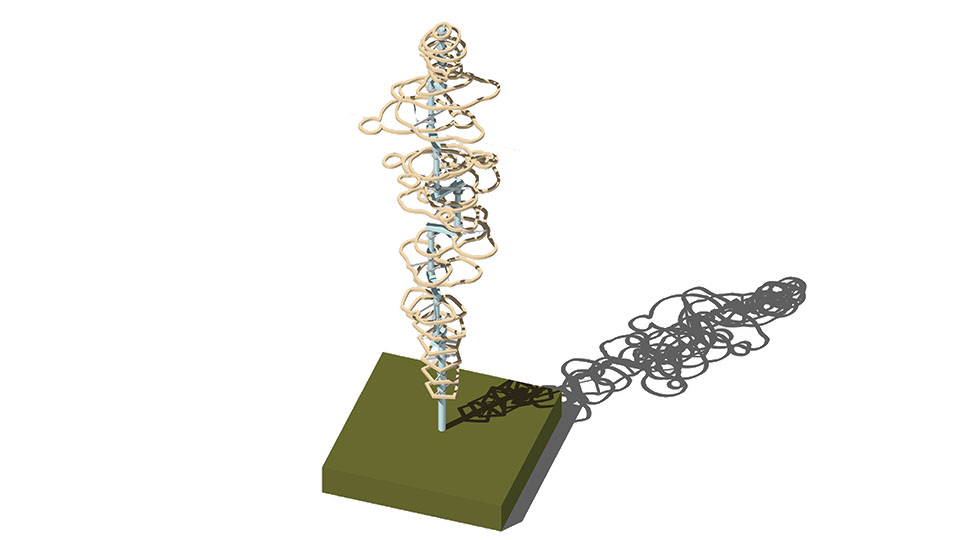
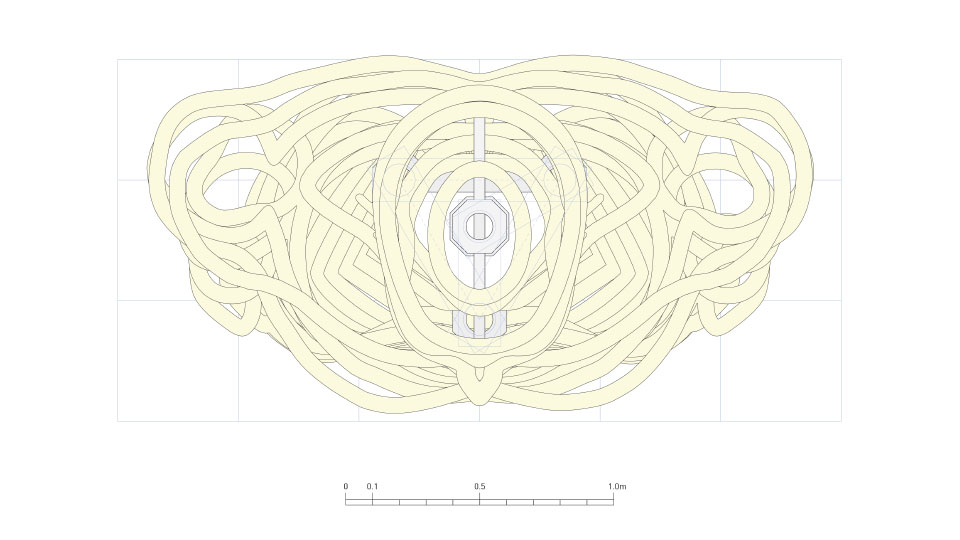
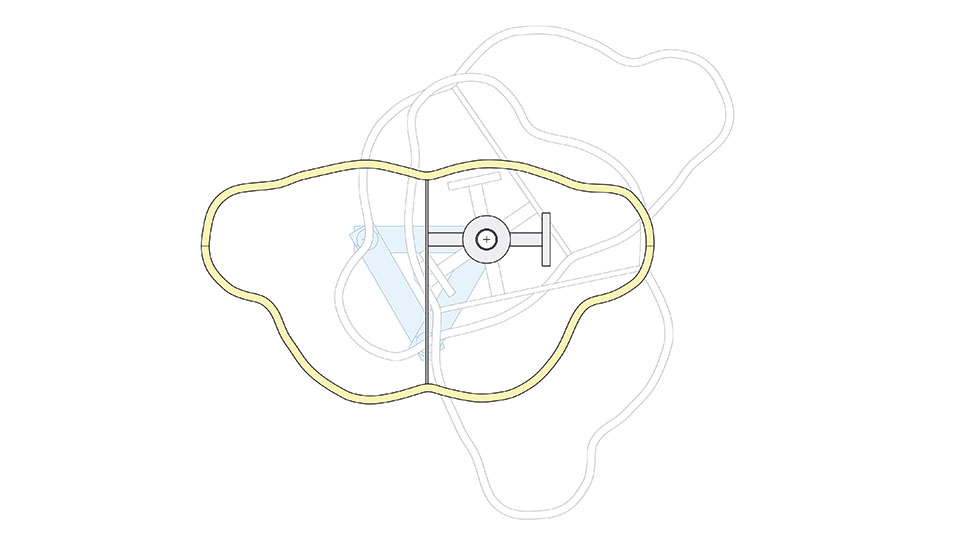
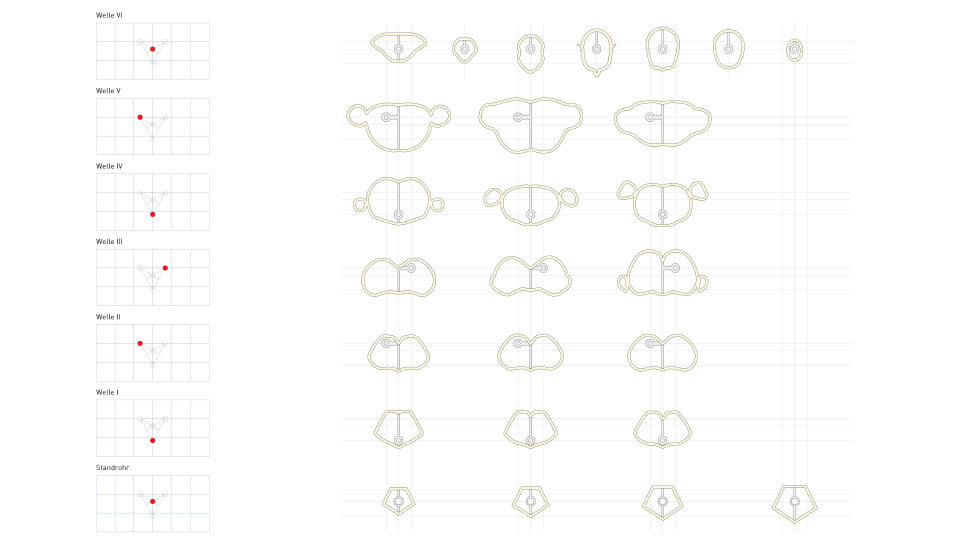
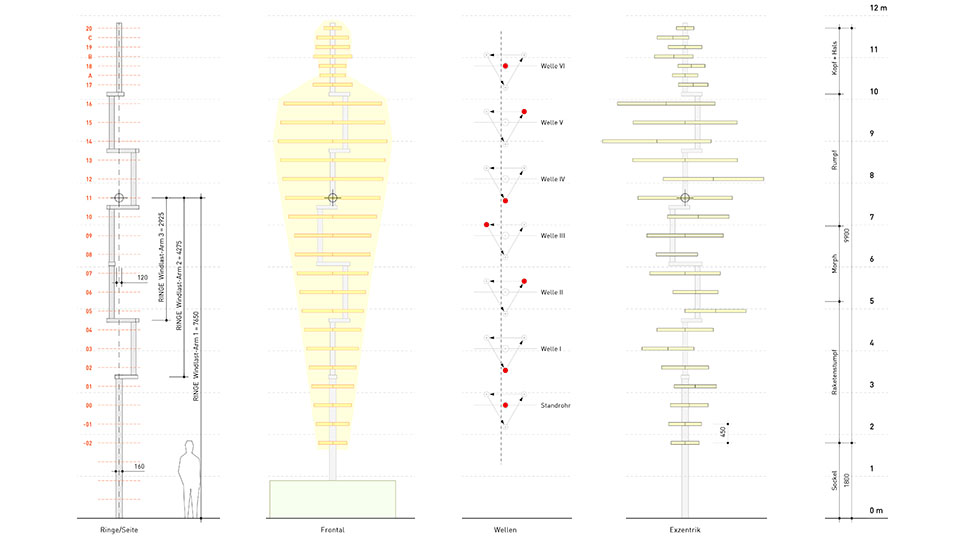
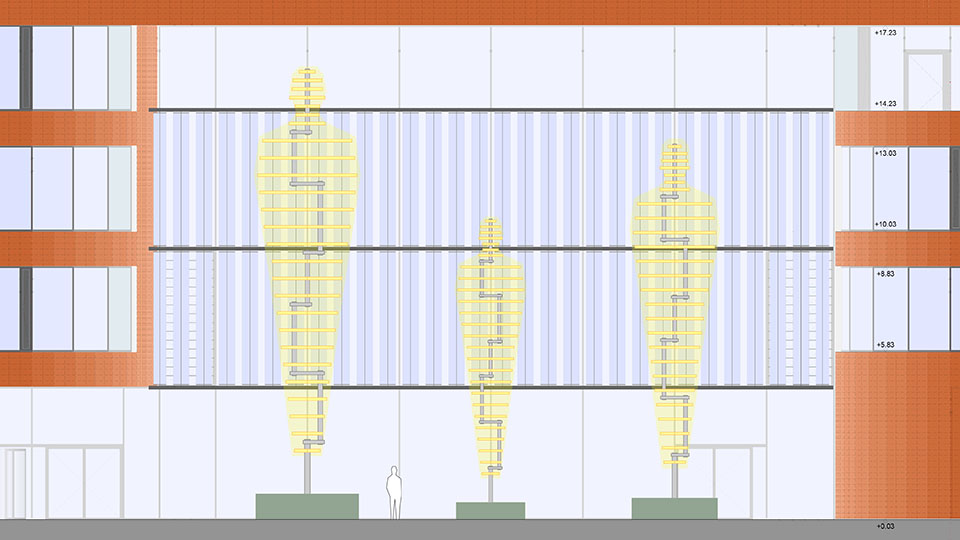
Ähnlich den Körperschnitten eines MRT’s in der Medizintechnik wird ein menschlicher Körper aus insgesamt 26 Schnitten nachgebildet. Jeder Schnitt wird als leuchtender Ring mittels eines Acrylglasprofils realisiert, sodass sich die Figur ein filigranes Volumen im Raum bildet, das in der Dunkelheit leuchtet.
Die Ringe werden im Inneren mit einem Abstand von je 45cm über eine mehrfach räumlich gekröpfte Achse zusammengehalten. Dieses „Rückgrat“ erinnert an eine Kurbelwelle, wie sie in Verbrennungsmotoren zum Einsatz kommt. Im Bereich des Kopfes wird die Anzahl der Ringe verdoppelt um eine für die Lesbarkeit adäquate „Sampling-Rate“ zu erreichen.
Die Form der aufrecht stehenden Figur setzt sich zusammen im Oberteil aus einem prototypischen 3D-Modell eines menschlichen Körpers und im Unterteil aus einem polygonalen Pyramiden-stumpf, der auf das Triebwerk einer Rakete verweist: auf etwa 1/3 der Gesamtlänge wird der Körper in Höhe der Beine als Morph in ein regelmäßiges 5-Eck überführt, das den untersten Abschluss bilden.
Standort
Die Figur hat eine Länge von 10m und steht etwas erhöht auf einem 1.8m langen Standrohr in der Sichtachse des Aufzug auf dem Platz vor dem Atrium. Mit einer Gesamtlänge von 11,8m endet der Scheitel etwa auf Kopfhöhe eines Nutzers der 2. Büroetage. Um Passanten vom Beklettern abzuhalten, kann der Bereich unter der Skulptur entweder als dichte Hecke oder – wegen der Spiegelungen noch attraktiver – als Wasserbecken ausgebildet werden.
Sichtbarkeit
Je nach Standpunkt ergeben sich sehr unterschiedliche Blickwinkel mit der entsprechenden raumdynamischen Wirkung. So wirkt das Volumen der Figur aus der Ferne eher ruhig, aus der Nähe, z.B. in der Untersicht vom Eingang oder der Aufsicht von der Sky-Loung, bekommt das Körpervolumen jedoch durch die starke perspektivische Verkürzung eine enorme räumliche Kraft. Position, Größe und geometrische Ausführung der Figur bedient eine Vielzahl von Standpunkten: von Straßenkreuzung, über Vorplatz, Eingang, Atrium, Aufzug und die Büros im linken und rechten Trakt, und – ganz wichtig – bis zur Sky-Lounge werden Alle erreicht!
Baukasten
Grundsätzlich ist der „Rocket Man“ – im Gegensatz zu einer klassischen, statischen, monolitischen Skulptur – als dynamisches, räumliches, filigranes Objekt konzipiert. Je nach Budget kann Bewegung auf der mechanischen wie auf der Licht-Ebene realisiert werden.
Standrohr: fest / drehend (ganze Figur kann sich drehen)
Ringe: fest / drehend (Leuchtringe drehen sich individuell um die Wellenachse)
Leuchtringe: leuchten kontinuierlich / dimmen einzeln / wie Lauflicht animiert
Animation
Aus gestalterischer Sicht liegt tagsüber der Focus auf der Mechanik, abends auf dem Licht: von einer fest stehenden Skulptur, die am Abend kontinuierlich leuchtet, über einen zwar mechanisch festen, aber durch Lichtspiele dynamiserten Körper . . . bis zu einer dynamisch bewegten Figur, die sich um ihre Achse dreht und deren Bestandteile sich in einem beständigem Wechsespiel von harmonischer Ordnung und expressiver Unordnung verändern, und deren mechanisches Spiel durch pulsierendes Licht überlagert wird, ist alles möglich!
//
Similar to the body cuts of an MRI in medical technology, a human body is reproduced from a total of 26 cuts. Each cut is realised as a luminous ring by means of an acrylic glass profile, so that the figure forms a filigree volume in space that glows in the dark.
The rings are held together on the inside, each 45cm apart, by a multiple spatially cranked axis. This „backbone“ is reminiscent of a crankshaft as used in combustion engines. In the area of the head, the number of rings is doubled in order to achieve an adequate „sampling rate“ for legibility.
The shape of the upright figure is composed of a prototypical 3D model of a human body in the upper part and a polygonal truncated pyramid in the lower part, which refers to the engine of a rocket: at about 1/3 of the total length, the body is transformed as a morph into a regular 5-corner at the height of the legs, which form the lowest conclusion.
Location
The figure has a length of 10m and stands somewhat elevated on a 1.8m long standpipe in the visual axis of the lift on the square in front of the atrium. With a total length of 11.8m, the top ends approximately at the head height of a user on the 2nd office floor. To prevent passers-by from climbing on it, the area under the sculpture can be designed either as a dense hedge or – even more attractive because of the reflections – as a water basin.
Visibility
Depending on the point of view, there are very different viewing angles with the corresponding spatial dynamic effect. Thus the volume of the figure appears rather calm from a distance, but from close up, e.g. in the bottom view from the entrance or the top view from the sky-loung, the body volume acquires enormous spatial power due to the strong foreshortening of perspective. The position, size and geometric design of the figure serve a multitude of viewpoints: from street intersection, to forecourt, entrance, atrium, lift and the offices in the left and right wings, and – very importantly – all the way to the sky lounge are reached!
Construction kit
Basically, the „Rocket Man“ – in contrast to a classical, static, monolithic sculpture – is conceived as a dynamic, spatial, filigree object. Depending on the budget, movement can be realised on the mechanical as well as on the light level.
Standpipe: fixed / rotating (whole figure can rotate)
Rings: fixed / rotating (illuminated rings rotate individually around the shaft axis)
Light rings: shine continuously / dim individually / animated like running lights
Animation
From a design point of view, the focus is on the mechanics during the day and on the light in the evening: anything is possible, from a fixed sculpture that shines continuously in the evening, to a mechanically fixed body that is made dynamic by the play of light, to a dynamically moving figure that rotates around its axis and whose components change in a constant interplay of harmonious order and expressive disorder, and whose mechanical play is superimposed by pulsating light!
P R O P O S A L Competition Vector Informatik Stuttgart 2015 + D E S I G N Standpipe: steel, stainless steel / Shafts: Steel, stainless steel Screws / Light rings: acrylic glass number: 26 pieces / total length 101 m / Illumination: LED, white, 4000 Kelvin / Power requirement 10 W/m / total: 1000 W / Size Typ M module 450mm / length of figure 10.00 m / total height: 11.80 m / width 2.60 m / depth 1.40 m / weight 1.050 kg / Foundation: 4.0x4.0x0.6 m / + S U P P O R T / + M E D I A 9 images © Christoph Hildebrand + T A G S Light / Proposal / Urban / +
